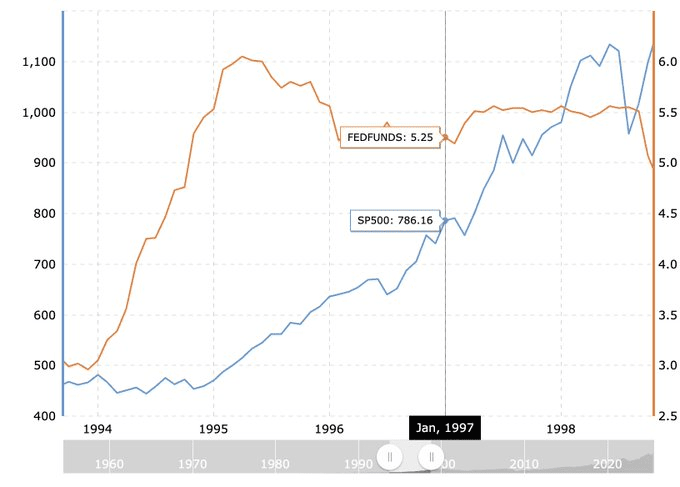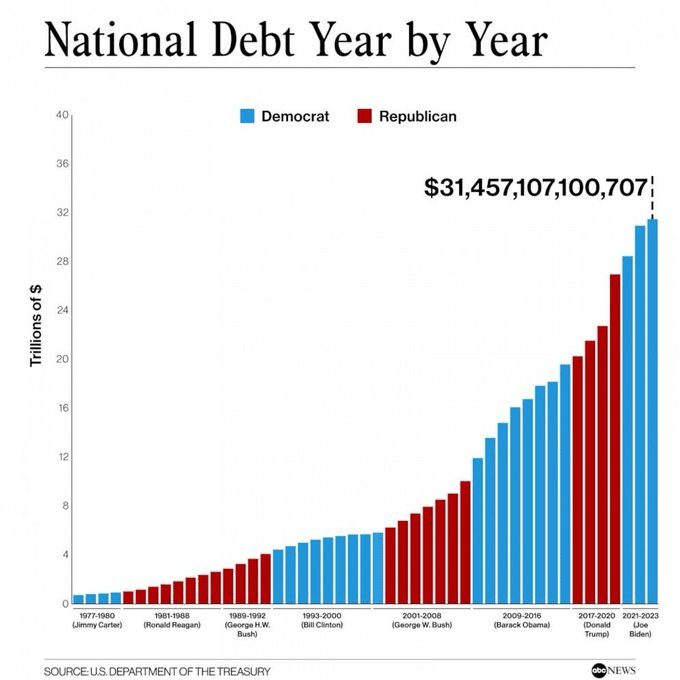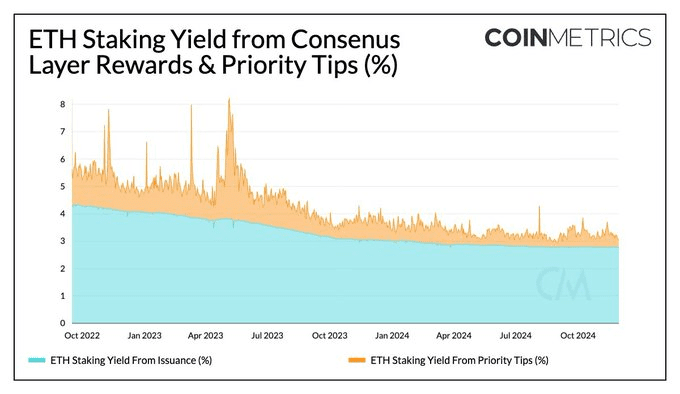The current market is generally focused on 'when will rates be cut', but what truly deserves attention is: the Federal Reserve maintaining high interest rates may actually be more beneficial for the long-term macro landscape of the U.S. stock market and crypto market. This view, although counterintuitive, points in the same direction from historical experience, fundamental structures, to the implicit easing driven by fiscal policy.
I. High interest rates ≠ bear market: history tells us that structural bull markets often emerge in high interest rate environments

For example, from 1994 to 2000, the Federal Reserve raised the federal funds rate from about 3% to 6%, and following this rate hike cycle, the U.S. stock market experienced one of the strongest tech bull markets in history:
The S&P 500 index rose from about 470 points to a peak of 1500 points in 2000;
The Nasdaq had an annualized return of over 25% from 1995 to 2000, driving a significant profit cycle before the 'internet bubble';
Corporate profits, technological innovation, and investment returns became dominant, rather than monetary easing itself.
This means that as long as the economy does not face a hard landing, high interest rates are not the culprit suppressing the stock market.
II. The essence of the current 'no rate cut' is confidence in the economy
As of July 2025, the Federal Reserve's target federal funds rate range is 4.25%-4.50%. Although it hasn't significantly eased, importantly— it hasn't raised rates either.
What this reflects is a reality where 'soft landing is being realized':
Core PCE inflation has decreased from its peak of 5.4% in 2022 to a range of 2.6%-2.7% by mid-2025;
GDP growth remains between 1.5%-3% annualized;
The unemployment rate is stable at 4.1%, with the labor market showing strong resilience;
The overall EPS expectation for U.S. stocks in 2025 is in the range of 250-265, with profitability recovering.
In other words, the essence of not cutting rates is that the Federal Reserve believes there is no need to intervene to rescue the market, as the market is self-repairing.
III. True 'easing' is being driven by fiscal rather than monetary policy
Although nominal interest rates have not changed, the current overall macro liquidity structure in the U.S. has shifted to 'fiscal-led stimulus'.

Trend of annual growth in U.S. federal debt
The U.S. fiscal deficit for 2024 is expected to exceed 6.4% of GDP, one of the highest since World War II;
As of July 2025, the total U.S. federal debt has exceeded $36.7 trillion;
In Q3 2025, net issuance of U.S. Treasury bonds is expected to exceed $1 trillion;
The 'Big Beautiful Bill' promoted by the Trump camp includes large-scale tax cuts and industrial subsidies, expected to increase the fiscal deficit by about $3 trillion over 10 years.
Even if the Federal Reserve remains inactive, such fiscal spending constitutes a de facto 'implicit easing'.
IV. High interest rates purify market structure, reinforcing the logic of the strong getting stronger
In a high interest rate environment, although financing difficulties have increased, it is actually a 'benefit' for large companies:
Apple holds over $130 billion in cash, Alphabet over $90 billion, and Meta nearly $70 billion;
At 4%-5% interest rates, this cash alone generates billions of dollars in interest income;
Small and medium-sized enterprises are marginalized in financing costs, with market share further concentrating in the hands of giants;
High cash flow buybacks drive EPS upward, making the valuation structure more robust.
This not only explains why the 'seven major tech stocks' still dominate the market capitalization rankings, but also clarifies why index assets can continue to reach new highs even amidst high interest rates.
V. Crypto Market: From Speculative Game to Structural Asset Allocation
Cryptocurrency was once seen as a speculative asset born from zero interest rates, but in the past two years, under a high interest rate environment, the market structure has undergone profound changes:
1) ETH/BTC has become a target for 'digital cash flow' and 'digital gold' allocation

Ethereum ETH staking yield trend (annualized)
Ethereum staking annualized yield remains between 3.5%-4.5%, possessing characteristics similar to government bonds;
BTC has become a core reserve asset for several publicly listed companies in the U.S. (such as MicroStrategy);
The introduction of ETFs, re-staking mechanisms, and on-chain governance financial returns have allowed ETH to present a combination of 'stable returns + asset scarcity'.
2) The 'interest margin dividend' of stablecoins has become an invisible profit pool
Circle is expected to earn over $1.7 billion in profits from U.S. Treasury interest income in 2024;
Tether earned over $4 billion in profits through reserve investments in the past year;
The stablecoin ecosystem has strengthened profitability under high interest rates, enhancing the stability of the entire DeFi infrastructure.
3) The survival logic of the crypto market is shifting toward 'cash flow' and 'systematic returns'
Speculative altcoins and memes are retreating;
Projects with clear revenue models, such as Uniswap, EigenLayer, and Lido, are favored by investors;
The market is beginning to evaluate on-chain assets based on 'ROE, cash flow, and inflation resistance'.
The crypto market is completing the transition from 'story trading' to 'structural trading'.
VI. Conclusion: This is a reassessment of asset logic, not a cycle of macro easing
While rate cuts can certainly push up asset prices, if not based on real profits and structural optimization, it will ultimately repeat the bubble burst after 2021.
This time, the U.S. stock market and the crypto market are following a healthier path:
High interest rates but controlled inflation;
Sustained fiscal stimulus, corporate profit recovery;
Strong companies gain cash flow advantages;
Cryptocurrency assets are returning to competition based on economic models.
A true slow bull market is not driven by a printing press, but by structural reallocation driven by pricing mechanisms and cash flow.
The current 'inaction' of the Federal Reserve is the key backdrop for this structural revaluation to occur.